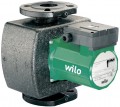Design
— Single head. The classical design provides one chamber with a working wheel. Among these pumps, there are models of almost any power and performance. Other things being equal, single pumps are cheaper than twin-head pumps. However they have a higher probability of failure, but in most cases, this is not of decisive importance, and the overall reliability is quite sufficient for both domestic and many professional tasks.
—
Twin head. Twin models are equipped with two impellers; in fact, such a unit consists of two pumps connected in parallel. It provides an increased degree of reliability compared to single designs: the twin-head pump continues to work even with a complete failure of one half (although the performance, of course, is reduced). In addition, it is easier to ensure good performance — as a result, even the most modest units of this type are capable of delivering about 6-7 thousand litres per hour. The reverse side of these advantages is the complexity of the design and, accordingly, the high cost; therefore, it is worth paying attention to such models in the case when high reliability and maintaining performance in case of malfunctions are critical for you.
Max. flow
The maximum flow of a pump is the amount of liquid it can pump in a certain amount of time.
Features of choosing the optimal performance option depend primarily on the purpose of the pump (see above). For example, for DHW recirculation models, the pump performance should not exceed the performance of the water heater. If the water heater is capable of delivering 10 litres per minute to the DHW circuit, then the maximum pump performance will be 10*60=600 L/h. The basic formula for calculating the performance of a heating system takes into account the power of the heater and the temperature difference at the inlet and outlet, and for the cold water system — the number of points of water intake. More detailed information about the calculations for each application can be found in special sources, and it is better to entrust the calculations themselves to professionals.
Features
— Number of speeds. The number of speeds provided in the design of the pump. Each speed corresponds to its performance value (see above). The options could be:
- 1 speed. There are no adjustments in such models; when turned on, the pump can operate only at one speed. This is the simplest and most inexpensive option, due to the absence of additional elements (regulators) in the design. Of course, it is convenient only in cases where the unit must operate at full capacity every time it is turned on.
- 2 speeds. 2 speeds give the user some degree of choice: the pump does not have to be turned on at full power — when it is not required, the unit can be run at reduced power to save electricity and not wear out the mechanisms beyond what is necessary.
- 3 speeds. The largest number of adjustments found in modern pumps — it makes no sense to provide a larger number for many reasons. It gives even more options for setting operation parameters than 2 speeds.
- Stepless adjustment. This option implies the ability to set the regulator to any position from minimum to maximum (in some models, fixed settings may also be provided, but only as an additional option). It provides maximum freedom and precision in the choice of operating mode. However, it significantly affects the price; and the real need for smooth adjustment occurs quite rarely.
—
Automatic operating mode.... The essence of this function differs depending on the purpose of the device (see above). So, in models for increasing the pressure of cold water, the automation turns on the pump when the tap is opened and turns it off when it is closed — a special sensor reacts to the movement of water. In models for heating and domestic hot water, automation is responsible for adjusting the operating parameters — for example, when screwing the valves and reducing the flow rate, the pump can reduce the pressure, as well as, for additional functions, such as an on-off timer. Anyway, this feature makes life easier for the user, eliminating the need to perform certain operations manually and adding new features to the pump; but the specific set of these features depends on the model.
— Display. Various additional information can be displayed on the display: operating mode, performance settings, water temperature, set timers, error messages and much more. It makes management more convenient and intuitive. Pumps usually use the simplest form of black and white LCD screens, but this is quite sufficient for the purposes mentioned.
— Control panel. In this case, the control panel means a panel that has a switch with a choice of operating modes between automatic (see above) and manual. Accordingly, the presence of several modes almost necessarily means the presence of a control panel. But the speed switches themselves are not considered for this function.Max. power consumption
The electrical power consumed by the pump during normal operation and maximum performance.
This indicator directly depends on performance — after all, for pumping large volumes of water, an appropriate amount of energy is needed. And the power depends on two main parameters — electricity consumption and the load on the power grid, which determines the connection rules. For example, pumps with a power of more than 5 kW cannot be connected to ordinary household sockets; more detailed rules can be found in special sources.

